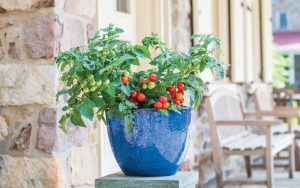Don’t let the dreaded tomato blight reduce your harvest to mush; Jean Vernon has some timely advice.

Anyone who grows tomatoes has probably experienced the highs and lows of the fantabulous greenhouse crop. Let’s be honest, tomatoes are fairly high maintenance. We spend time and effort sowing, growing, repotting, tying in, pinching out and feeding.

Then the plants start to flower and we watch, wait and sometimes hand pollinate to ensure a fruit. We water and feed, and water and feed, and tie in some more, and water and feed, and the little marbles swell and blush into full blown fruit. And then disaster. Just as our tomato harvest is bursting into production, the tell tale signs of a fungal disease so deadly it caused a famine and cost the lives of hundreds and thousands of people. Blight. Potato blight. Tomato Blight. It’s one and the same and it attacks potatoes and tomatoes in our gardens and sometimes in the greenhouse too.

Beating tomato blight
Blight is more common in wet and cool summers, there’s even warning system that triggers when temperature and humidity is perfect for the disease to spread. So what can you do to minimise the problem?
First, grow your tomatoes in the greenhouse where the glass panes and enclosed space will partially protect your plants from air borne spores. It helps, but it won’t stop the disease taking hold, especially in a bad year.
The very best way to avoid blight ruining your tomatoes (and potatoes) is to grow blight resistant varieties. These have been bred to exhibit good blight resistance by identifying blight resistant genes within the plant breeding lines. It’s been a project for Burpee Europe resulting in Crimson Crush which has two blight resistant genes and has been a top taste in blind taste tests by Suttons Seeds. It’s such a winner that Which? Gardening put it at the top of its table for blight resistance and yield. What’s more they can be grown outdoors in more southerly counties, which is a rare benefit in terms of, blight resistant tomatoes.
Family traits

Crimson Crush has been such a success, that breeding continued and the family now includes Cocktail Crush and Rose Crush, both resistant to the ravages of tomato blight. And the great news is that Rose Crush is a larger, beefsteak type fruit, perfect for summer salads, washed with balsamic vinegar and honey.
Also from the Burpee Europe tomato breeding comes Nagina, which is a fabulous early ripening plum tomato. Plums are top of my tomato list and this one is a real winner offering blight resistance and great texture for all my summer dishes and tomato-based delights.
Tomatoes galore
As the fruit starts to show the first blushes of summer and they ripen on the stems, the smell is intoxicating inside the greenhouse. I love to pick them from the plants as I water and tend to their needs, it’s better than pick and mix and there’s something about a greenhouse warm tomato picked fresh and eaten immediately, it feels like forbidden fruit and the flavour is divine.

A basket of fruit is the perfect addition to a summer feast, picnic or salad. And if this year your fruits are blackened by blight, you know what to do from now on. Grow a reliable blight resistant variety from seed next season and banish the blight agony from your memory banks. Take advantage of the science and the breeding by the fruit-breeding experts at Burpee Europe (www.burpeeeurope.com) for some of the tastiest tomatoes from seed. Growing from seed means you can grow more unusual varieties and have many plants to grow and share.


